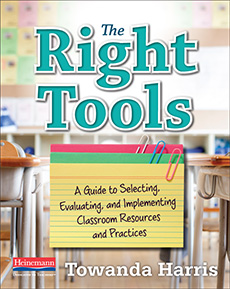Evaluate and Refresh Your Literacy Resources
The Right Tools: A Guide to Selecting, Evaluating, and Implementing Classroom Resources and Practices
By Towanda Harris
(Heinemann Publishing, 2019 – Learn more)
 Reviewed by Erin Corrigan-Smith
Reviewed by Erin Corrigan-Smith
We are all guilty of it! How many times have we decided “Well, this is the resource I could find, so I am going to use it!” And then we wonder “What went wrong?”
So often, we have a plethora of educational materials on hand, either teacher created, team created, purchased, or inherited from a co-worker. But what do we know about them, really?
Using the materials available, without doing a thorough vetting of them, often leads to less-than-stellar results. Using a system to review the materials at our disposal and determining which are the strongest and the weakest can only serve to make our jobs a little simpler in the long run.
 Towanda Harris is Her book The Right Tools: A Guide to Selecting, Evaluating, and Implementing Classroom Resources and Practices focuses on how to help teachers become better equipped to weed through all the instructional tools and materials available to them.
Towanda Harris is Her book The Right Tools: A Guide to Selecting, Evaluating, and Implementing Classroom Resources and Practices focuses on how to help teachers become better equipped to weed through all the instructional tools and materials available to them.
Tracking student progress
Harris aims her advice at grades K-5 and the focus is on literacy instruction. The Right Tools begins with a section on student assessment where students are tested to see where they truly are, so that we can make the most informed decisions about where students need to go next.
The first chapter includes practical advice on a keeping student’s scores in what she refers to as a “Student Progress Tracker.” This tracker gives a “place to record brief notes about each student so that you can look across all of the available data—quantitative and qualitative—at once” (pp. 3-4).
Downloadable copies of the tracker are available, as is a larger selection of samples to follow the first time you attempt to track. The tracker can accommodate handy information such as IEPs, strengths, needs, and reading levels. Practically, this tool for tracking literacy development is more “ready to use” in an elementary or self-contained setting, though it could be modified for middle or high school as well. Realistically, in the upper grades it is unlikely all aspects of the tracker could be used, but for identifying the biggest areas in which students need to improve, this is a great way to track progress over time.
Also included in the first chapter is a breakdown of how to use assessments in the most reliable and useful way. Not every assessment needs to be “formal,” and Harris gives practical advice on what to do, when to do it, and how to interpret the data in the most beneficial way.
Evaluating what you have
Chapter 2 (How Good Is It?) breaks down all the information that educators should be assessing when reviewing potential materials. Harris includes a printable checklist that breaks everything down into five categories: Stages, Skills, Grouping, Expected Outcomes, Depth of Knowledge. Yes, it is time-consuming to create a spreadsheet like this, but by frontloading the information on materials, their use and value can be better assessed, and lessons will be more successful because of it.
Each chapter includes a “discussion” page where Harris reaches out to the reader on a personal level and offers honest, constructive, and beneficial ideas on how to work smarter, not harder, when searching for materials. The book is logical in its approach to materials, and it causes readers to reflect on how they are currently assessing and using their own materials within the classroom and whether they could improve.
Finding what you need
The most engaging part of the book is the amazing amount of included resources. The “Student Progress Tracker” serves to keep educators on target with instruction. All the appendixes are in color and are downloadable from the Heinemann website, so implementing them is very quick and easy. There is a chart for student goal setting which can be used along with the tracking so that the educator and students come to the discussion table each knowing where the student currently falls in mastery and where they can (realistically) get to.
This book is an uncomplicated tool that can be utilized to assist educators with assessing what they have, what they need, and how and where they can find it. There is nothing in the book about shaming teachers for using the resources of others. Rather, it offers a means to review what is found in order to be even more effective in the classroom.
Erin Corrigan-Smith is a middle school ELA teacher in a suburb of Atlanta. She has a B.A. and M.A. in English, and her focus of study is children’s literature. During the school year, she is faculty advisor to the Book Worms book club. In her downtime, she enjoys going to her family’s cabin in the North Georgia mountains, with her husband and dog, to read, craft, and relax.

































